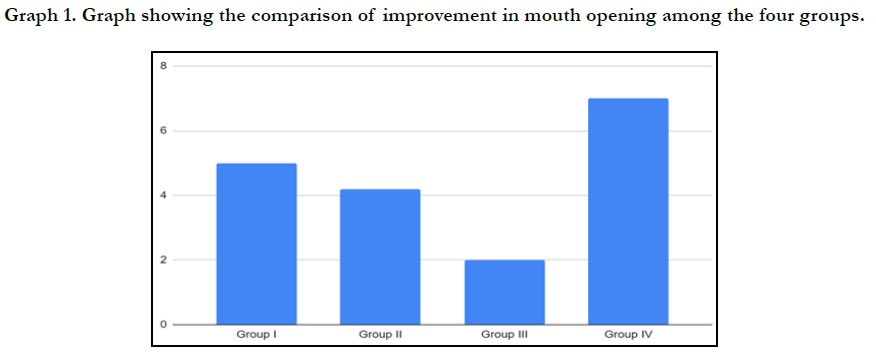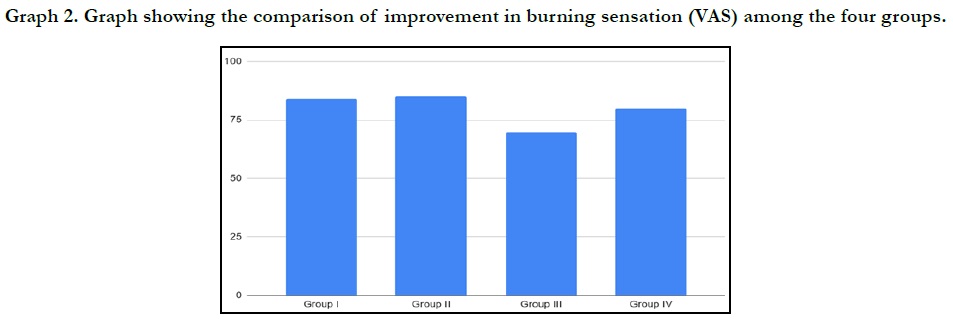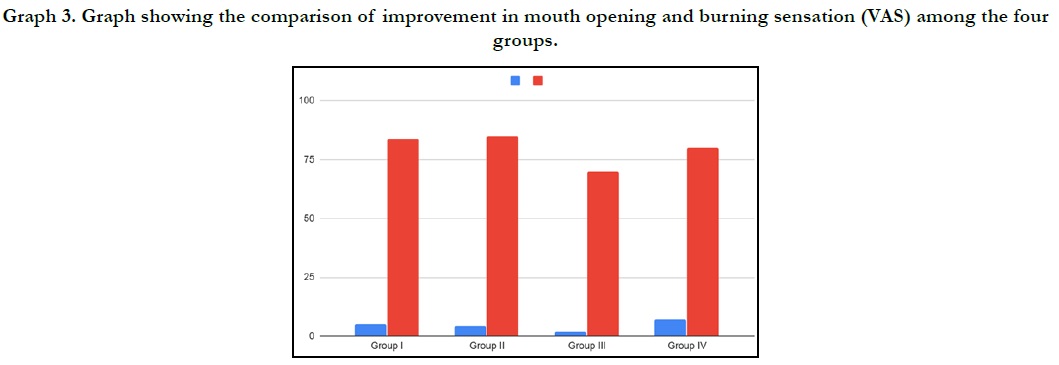Evaluation of the Efficacy of Turmeric in the Management of Oral Submucous Fibrosis
Prabu Mahin Syed Ismail1, Kyatsandra Narasimhaiah Jagadeesh2, Anju Anu Jose3*, Shruthi S Hegde4
1 Department of Restorative dentistry, Department of Conservative Dentistry and Endodontics, College of Dentistry at AL Russ, Qassim University
Kingdom of Saudi Arabia.
2 Professor, Department of Prosthodontics and implantology, Sri Siddhartha Dental College, Sri Siddhartha Academy of Higher Education, Tumkur, Karnataka, India.
3 Associate Professor, Department of Oral Medicine and Radiology, School of Dental Sciences, Sharda University, Greater Noida, Utter Pradesh,
India.
4 Department of Oral Medicine and Radiology, Srinivas institute of Dental sciences, mukka Suratkal, Mangalore, Karnataka, India.
*Corresponding Author
Dr. Anju Anu Jose,
Associate Professor, Department of Oral Medicine and Radiology, School of Dental Sciences, Sharda University, Greater Noida, Utter Pradesh, India.
E-mail: anju.jose@sharda.ac.in
Received: August 30, 2020; Accepted: September 14, 2020; Published: September 18, 2020
Citation:Prabu Mahin Syed Ismail, Kyatsandra Narasimhaiah Jagadeesh, Anju Anu Jose, Shruthi S Hegde. Evaluation of the Efficacy of Turmeric in the Management of Oral Submucous Fibrosis. Int J Dentistry Oral Sci. 2020;7(9):820-823. doi: dx.doi.org/10.19070/2377-8075-20000161
Copyright: Anju Anu Jose©2020. This is an open-access article distributed under the terms of the Creative Commons Attribution License, which permits unrestricted use, distribution and reproduction in any medium, provided the original author and source are credited.
Abstract
Background: Oral submucous fibrosis is a potentially malignant condition and its treatment poses a great challenge. One new
treatment modality which has gained recognition is the use of turmeric.
Objectives: The aim of this study was to evaluate the efficacy of turmeric in the patients of oral submucous fibrosis.
Materials and Methods: Sample sizes of 60 subjects diagnosed with oral submucous fibrosis were included in this study. The
patients were administered commercially available turmeric. The mouth opening and burning sensation of patients on VAS
scale were evaluated at regular intervals. The data was compared using SPSS 26.0 version.
Results: It was found out that there was significant improvement in the burning sensation on VAS but the improvement in
mouth opening was not significant.
Conclusion: From the study, it was concluded that turmeric can be used for the treatment of oral submucous fibrosis and to
improve the burning sensation.
2.Introduction
3.Materials and Methods
4.Results
5.Discussion
6.Conclusion
7.References
Keywords
Oral Submucous Fibrosis; Burning Sensation; Turmeric; Visual Analog Scale.
Introduction
Oral submucous fibrosis (OSMF) is a chronic insidious disease
which can affect any part of the oral cavity sometimes pharynx
which is although occasionally preceded by or it is associated with
formation of vesicles. It is always associated with a juxta epithelial
inflammatory reaction which is followed by fibroelastic changes
of lamina propria with epithelial trophy which leads to stiffness
of oral mucosa causing trismus and inability to eat [1].
The epithelium is atrophic and shows firstly an intercellular edema
which is later followed by epithelial atypia that is associated with
moderate epithelial hyperplasia. After this stage, the carcinoma
can start to develop at any time. Various studies have reported
that those patients who are suffering from OSMF are at higher
risk of developing oral cancer. Its malignant transformation rate
has been reported to be about 7.6% [2].
There has been said to be multiple factors responsible for occurrence
of OSMF. However, there is no single pathophysiology
which has been agreed on. That is why, there is no effective treatment
and the management of OSMF is still a great challenge [3].
Recently, a new treatment modality has gained recognition which
is the use of turmeric in the treatment of OSMF. There have been
few studies conducted to assess the potential role of turmeric and
its active component, curcumin, which acts as a chemo-preventive
agent. The chemo-preventive action of curcumin comes from its
anti-inflammatory and antioxidant properties. In-vitro studies have
been carried out to show the anti-inflammatory and antioxidant
activities of curcumin which inhibit lipo-oxygenase and cyclooxygenase
(COX) activities which are responsible for inducing
inflammation [4].
Various studies have shown that curcumin lowers the activity of
smokeless tobacco extract (STE) or nicotine derived nitrosamine ketone (NNK)- induced nuclear factor kappa-light-chain-enhancer
of activated B cells (NF-kB) and COX-2 in the cells of oral
premalignant lesions and cancer [5]. The turmeric works by raising
the number of micronuclei in the circulating lymphocytes and
it acts as a very good scavenger of free radicals [3].
Since very few studies have been conducted on the efficacy of the
use of turmeric in the treatment of OSMF, hence this study was
carried out to analyze the role of turmeric in the treatment of
patients having OSMF.
Materials and Methods
This study was conducted in the Department of Oral medicine.
Sixty patients were selected for the study who had been clinically
diagnosed with OSMF. The patients were selected in the age range
of 21-30 years. Informed consent was taken from the patients for
the study. Ethical approval was obtained from the institutional
ethical committee.
Detailed history was taken and complete hemogram was done
for every patient to rule out any other pathophysiology. Inclusion
criteria were; Patients clinically diagnosed with OSMF. Exclusion
criteria were; Patients showing malignant changes and Patient not
willing to get treatment done.
The patient’s mouth opening was measured with the help of a
digital vernial caliper. On the visual analog scale (VAS), the burning
sensation was recorded. The patients were divided into four
groups which were on the basis of interincisal distance according
to Lai’s [6] i.e. Group I: Interincisal distance > 35 mm, Group II:
Interincisal distance between 30 mm - 35 mm, Group III: Interincisal
distance between 20 mm - 30 mm, Group IV: Interincisal
distance < 20 mm.
Each patient was given Turmix tablet which is a commercially
available turmeric product. It contains 300 go of curcumin and 5
mg of piperine. The tablet was given thrice daily for one month.
The patients were called thrice each month and at each visit, the
patient’s mouth opening and burning sensation were noted.
The data was tabulated and analyzed statistically using IBM SPSS
Statistics for Windows, Version 26.0. Armonk, NY: IBM Corp
using Student’s t-test at significance of 0.05.
Results
The mean age of the patients in the study group was 35.1 ± 11.4
years. The male:female ratio was 2.5:1. According to Lai’s classification6,
these subjects were divided into four groups. with 15
samples in each group (Group I-IV). After one month, Group
I showed an improvement of 5 % in mouth opening with an
improvement of 84% in burning sensation on VAS. Group II
showed an improvement of 4.2 % in mouth opening and 85 % in
burning sensation. Group III showed 2 % improvement in mouth
opening and 70% in burning sensation. Group IV showed a 7 %
improvement in mouth opening and 80 % in burning sensation.
Graph 1 shows the comparison of improvement in mouth opening
among the four groups. Graph 2 shows the comparison of
burning sensation (VAS) among the four groups.From the results,
it was concluded that Group IV showed the maximum improvement
in mouth opening and Group III showed the least improvement.
Group II showed maximum improvement in burning sensation
while Group III showed the least improvement.
Graph 2. Graph showing the comparison of improvement in burning sensation (VAS) among the four groups.
Graph 3 shows comparison of improvement in mouth opening and burning sensation (VAS) in all the four groups. On comparing the data, the improvement in burning sensation on VAS was found to be statistically significant (p < 0.001) while improvement in mouth opening was not statistically significant.
Graph 3. Graph showing the comparison of improvement in mouth opening and burning sensation (VAS) among the four groups.
Discussion
Schwartz, in 1952 found an oral fibrosing disease in five Indian
women from kenya and named it as atrophica idiopathica mucosa
oris [2]. In 1953, this condition was named as submucous fibrosis
(OSMF). It is defined as an insidious, chronic diseases affecting
any part of the oral cavity and sometimes the pharynx which is
occasionally preceded by and/or associated with formation of
vesicle and is always associated with a juxtaepithelial inflammatory
reaction which is followed by progressive hyalinization of the
lamina propria [6, 7].
Cox and Aziz in 1997 stated that in OSMF, the increasing inability
to open the mouth in a patient is the most common complaint
which occurs as a result of accumulation of fibrous tissue in the
juxtaepithelial region of the oral mucosa. Paymaster in 1956 was
the first person to describe that OSMF has precancerous nature
when he had noticed a slow-growing squamous cell carcinoma (SCC) in the patients who had been diagnosed with OSMF [2].
However, the etiology as well as the pathogenesis of the disease
is still not well known due to which it is believed that there can be
many causative factors of OSMF. In 1968, Pindborg and in 1986,
Caniff et al., has described the disease as a reaction to capsaicin,
which is present as an irritant in chilies but it has not been completely
proved yet. In spite of various number of factors responsible
for causation of OSMF, an effective treatment is yet to be
devised for it.
Recently, treating OSMF with turmeric is gaining recognition as a
treatment modality. The principal curcuminoid which is the curcumin
comprises about 2-5% portion of turmeric.
When the patients were treated with turmeric, an improvement
in mouth opening as well as burning sensation was noticed in all
the groups (Graph 3). The maximum amount of improvement
was seen in Group IV patients. It could be due to fibrinolytic and
antiinflammatory actions of curcumin and also the severity of
fibrosis and inflammation was maximum in Group IV. Curcumin
is said to exert anti-inflammatory activity by inhibiting different
molecules which participate in the inflammation process [8].
The fibrinolytic property of curcumin is also due to its ability
to inhibit lipid peroxidation and putting cellular proliferation in
cheek. This leads to reduction in the rate of collagen synthesis [9].
We observed improvement in burning sensation on VAS. Maximum
improvement was noted in Group II patients because they
had the majority of erosions present when clinically examined.
On assessing the overall mouth opening was not statistically significant
(p = 1.5); while the improvement in mouth opening was
statistically significantly similar to studies carried out by Agrawal et al in 2014 [2]. Das et al., observed improvement pattern in
mouth opening as well as burning sensation similar to our findings
[10]. Saran et al., on evaluation observed that Lycopene had
better results than curcumin in improving mouth opening; however,
both the drugs were equally effective in decreasing burning
sensation in OSMF patients [11]. Rai et al., found that curcumin
is effective on OSMF if administered both systemic and topical
forms together [12].
Further long term studies are required to evaluate efficacy of turmeric
with other herbal content to improve burning sensation and
OSMF.
Conclusion
From our study, it was concluded that in the OSMF patients, turmeric
has a therapeutic effect. The role of turmeric in oral cancers
can be very promising. However, more studies are required
to determine its efficacy.
References
- Khan S, Sinha A, Kumar S, Iqbal H. Oral submucous fibrosis: Current concepts on aetiology and management - A review. J Indian Acad Oral Med Radiol.2018 Oct 1;30(4):407.
- Agarwal N, Singh D, Sinha A, Srivastava S, Prasad RK, Singh G. Evaluation of efficacy of turmeric in management of oral submucous fibrosis. J Indian Acad Oral Med Radiol.2014 Jul 1;26(3):260.
- Taneja L Nagpal A, Vohra P, Arya V. Oral submucous fibrosis: An oral physician approach. J Innov Dent 2011;1:14-18.
- Bar-Sesla G, Epelbaum R, Schaff er M. Curucumin as an anti-cancer agent: Review of the gap between basic and clinical applications. Curr Med Chem .2010 Jan 1;17(3):190-7.
- Rai B, Kaur J, Jacobs R, Singh J. Possible action mechanism for curcumin in pre-cancerous lesions based on serum and salivary markers of oxidative stress. J Oral Sci.2010;52(2):251-6.
- More CB, Gupta S, Joshi J, Varma SN. Classification system for oral submucous fibrosis. J Indian Acad Oral Med Radiol. 2012;24:24-9.
- Passi D, Bhanot P, Kacker D, Chahal D, Atri M, Panwar Y. Oral submucous fibrosis: Newer proposed classification with critical updates in pathogenesis and management strategies. Natl J Maxillofac Surg. 2017 ;8(2):89-94.
- Akram M, Shahab-Uddin AA, Usmanghani KH, Hannan AB, Mohiuddin E, Asif M. Curcuma longa and curcumin: a review article. Rom J Biol Plant Biol. 2010;55(2):65-70.
- Lawande SA. Therapeutic applications of turmeric (Curcuma longa) in dentistry: A promising future. J Pharm Biomed Sci .2013 Feb;27(27):586-91.
- Das AD, Balan A, Sreelatha KT. Comparative study of the efficacy of curcumin and turmeric oil as chemopreventive agents in oral submucous fibrosis: A clinical and histopathological evaluation. J Indian Acad Oral Med Radiol. 2010 Apr 1;22(2):88.
- Saran G, Umapathy D, Misra N, Channaiah SG, Singh P, Srivastava S, et al. A comparative study to evaluate the efficacy of lycopene and curcumin in oral submucous fibrosis patients: A randomized clinical trial. Indian J Dent Res . 2018 May 1;29(3):303.
- Rai A, Kaur M, Gombra V, Hasan S, Kumar N. Comparative evaluation of curcumin and antioxidants in the management of oral submucous fibrosis. J Investig Clin Dent. 2019 Nov;10(4):e12464.











